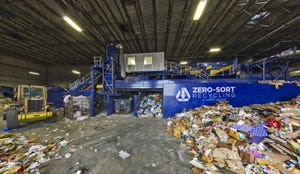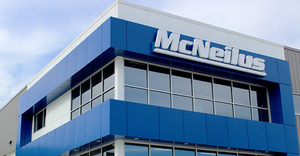The Load Less Traveled
Route optimization software can save waste companies significant money and improve customer service, too.

To Nick Fahey, area manager of the family-owned Southern Oregon Sanitation hauling firm in Grants Pass, Ore., the clunky term “route optimization” breaks down to some very simple concepts, the cornerstone of which is making more money without skimping on customer service.
“To me, it's about how we can do a route faster, pick up for more customers in a driver's day, reduce the overall mileage for the fleet, and reduce the trips to the landfill/transfer facility,” Fahey says. “I want to be as profitable for the company as possible without impacting the customer financially. Because, the more efficient we are as a company, the longer we can put off a rate increase for our customers — and that keeps them happy.”
For Southern Oregon that's important, as it's a third-generation family business that's been operating in Oregon's Josephine and Jackson counties for over 60 years, serving both commercial and residential customers.
“'Route optimization' involves the creation of the least amount of routes to service customer stops and sequencing those stops in the most efficient order to minimize travel time or distance,” says Ewe-Leng Lim, chief knowledge officer at the Institute of Information Technology (IIT), a route optimization software provider based in Magnolia, Texas. “It means servicing more customers with the least number of vehicles and minimizing driving time and distances while meeting all business constraints.”
It can even involve such details as when drivers should leave for the landfill, when they should resume their collection routes and lunch break considerations, Lim says.
Making It Work
Southern Oregon's Fahey points out that a refuse fleet needs to do its homework before it can install a route optimization system and use it properly. Route optimization also involves spending cash — in Southern Oregon's case, roughly $20,000, he says.
Fahey's firm used two software packages — FleetRoute, a product of Germany's CIVIX LLC, and ArcView, a geographic information system (GIS) developed by Redlands, Calif.-based ESRI — to begin the process of building more efficient routes. But, the firm needed to gather some information before it could start using the packages.
The information included:
City and county maps
Customers' global positioning satellite (GPS) map points
What size of container each customer has
The average weight of trash in the container
How often a customer is serviced
Where the fleet's trucks are housed
What transfer site or landfill the vehicles use
The maximum tonnage of refuse that a particular truck can hold
How long it takes to unload a particular truck at a transfer facility or landfill
Street segment speeds and lengths
Length of the drivers' lunch breaks
How much time it takes for pre- and post-trip truck inspections
How long the fleet expects that driver's day to be
“All of these variables need to be input into the computer program to get appropriate routes,” Fahey explains. “Once we had this data, we then began manipulating it using the [software].”
Karl Terrey, product manager for ESRI's ArcLogistics software suite, notes that it typically requires several days worth of consulting and implementation before a route optimization system can go “live.”
“The flow of data must be carefully examined so that the correct information is available for the route optimization application,” Terrey says. “Once the data to be routed is made available, it must be ‘geo-coded’ to a specific side of a street segment and placed at the location of the pickup. Many systems will include a ‘geo-coding’ mechanism as a part of the application.”
Once the data and mechanisms to get it into the optimization software are validated, Terrey says the average person needs about one to three days to be trained on the system's workflow and functions. “Usually, it is all ‘back office’ personnel doing this work — allowing drivers to keep carrying out their days' work as usual.”
In Southern Oregon's case, Fahey says it took two weeks to set up the map appropriately. “For us there was a steep learning curve,” he says. “It took us at least a month to figure everything out to make the program work correctly with the customer data.”
Getting Buy-In
A critical part of the route optimization process is getting “buy-in” from both the refuse fleet's drivers and supervisors. Fahey notes that, in his company's case, they mapped out original routes and laid them alongside the new proposed routes for review by both drivers and supervisors alike, a critical step in getting them to accept the new system.
“This also allowed us to modify the customers' GPS point in the computer,” he explains. “If a customer is for some reason out of sequence, per the driver's suggestion, we can check the validity of that customer's point. If the point is in an incorrect place - usually, it's just across the street - we can move it without a lot of trouble.”
Fahey says the driver's input into this process is essential, as sometimes the map provided by the municipality is incorrect. Drivers also are the first to notice major discrepancies, such as one-way streets marked as two-way roads, or an intersection you cannot turn at.
“Even after a successful routing, that driver may have further suggestions for that route,” Fahey says. “Throughout the routing process, there needs to be contact between the driver and the person using the software.”
Lim stresses another key point as well: though the routing optimization process is designed to improve efficiency, that doesn't necessarily translate into driver positions being eliminated. “The most obvious savings comes when our route optimization can cut out a number of routes from an operation. That translates to less vehicles and driver time, which saves vehicle maintenance and driver cost,” he says. “Yet that does not necessarily mean the elimination of drivers or vehicles. Instead, these are freed up to do other work, which translates to generating additional business and revenue. In addition, for each route we are providing more efficient sequencing to service customer stops and optimal travel paths to reduce driving time and mileage.”
The End Result
So what should a refuse fleet get out of the route optimization process? In Southern Oregon's case, significant costs savings alongside improved customer service indices. “We started this project six months ago with 10 automated routes covering 23,000 customers,” Fahey says. “Through this process — and through necessity — we have reduced the number of routes to nine.”
Removing a single driver for Southern Oregon equals a savings of over $60,000 each year, but this does not yet include the removal of an automated truck from the fleet - a vehicle that becomes a spare and allows the company to put off the purchase of another automated truck for another year. “That's saving capital expenditures of over $200,000 for 2009,” Fahey says. “So, for $20,000 in software, we realized a large financial advantage — removing a driver — and have a large section of capital expenditure for other projects.”
Route optimization also allows the company to be more flexible in the face of unexpected change. “First and foremost, it takes the human feeling element out of the re-routing discussion,” Fahey says. “You can make decisions based on pure numbers, not what a manager feels is better or worse.”
In Southern Oregon's case, that “removal of a driver” Fahey cites wasn't about laying someone off — it was about coping with a military reservist called up by the National Guard for duty in Afghanistan. “This [system] provided us with the opportunity to cover his route without hiring another driver,” Fahey notes. “As any manager will acknowledge, that's a big deal - removing a driver and ultimately a truck and route from service.”
Finally, there's the customer service benefit from using route optimization software, he says. “We are now giving the customer an estimated time of arrival,' which is a capability we did not previously have,” Fahey explains. “We previously had a rough idea in the office of when that driver will show up in a customer's neighborhood. Now we can pinpoint any customer by the minute. Granted, it does not include extenuating circumstances, but that is much closer than the previous level of information we were able to provide.”
Sean Kilcarr is a senior editor for Fleet Owner, a sister publication of Waste Age.
About the Author
You May Also Like


